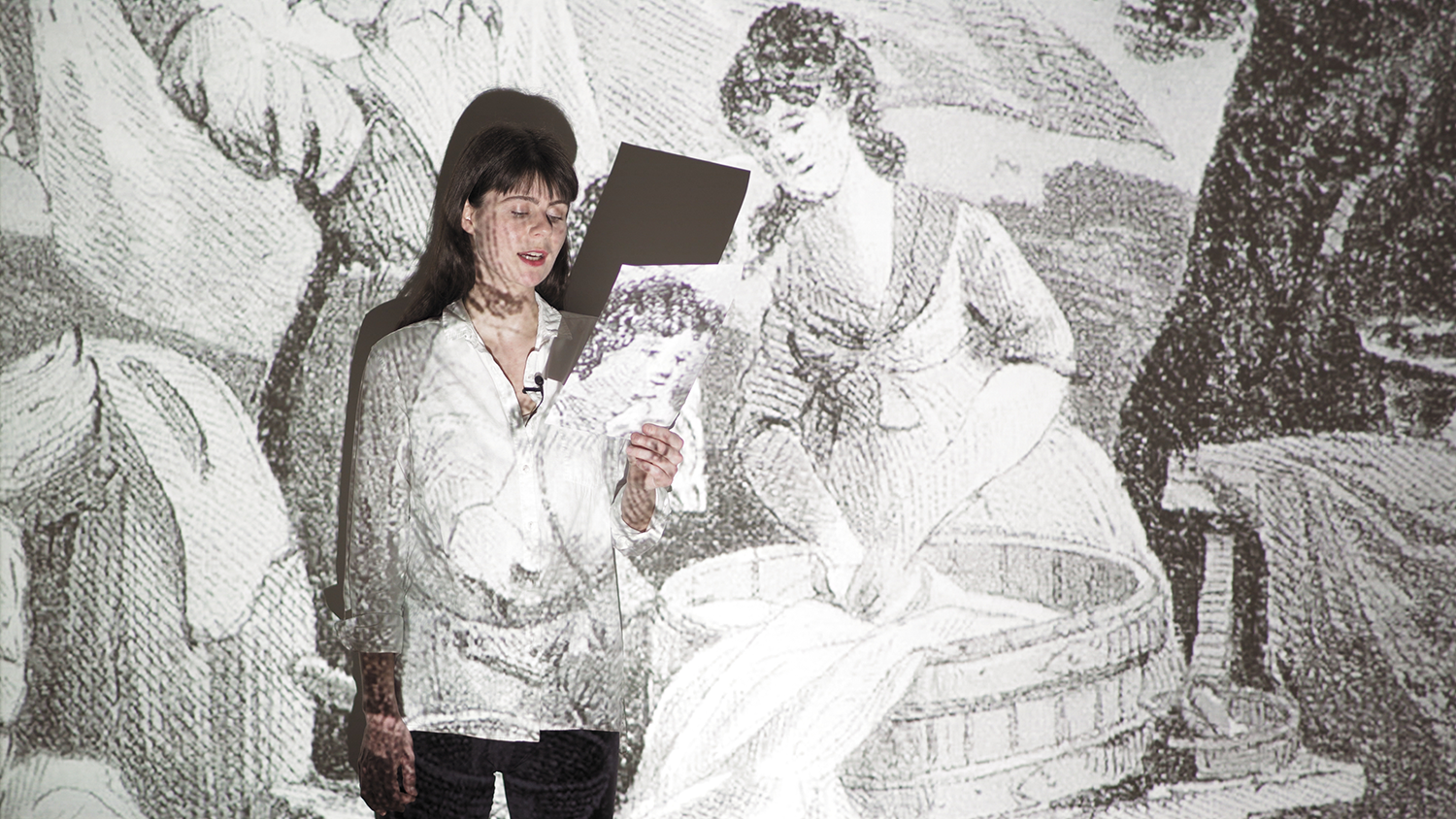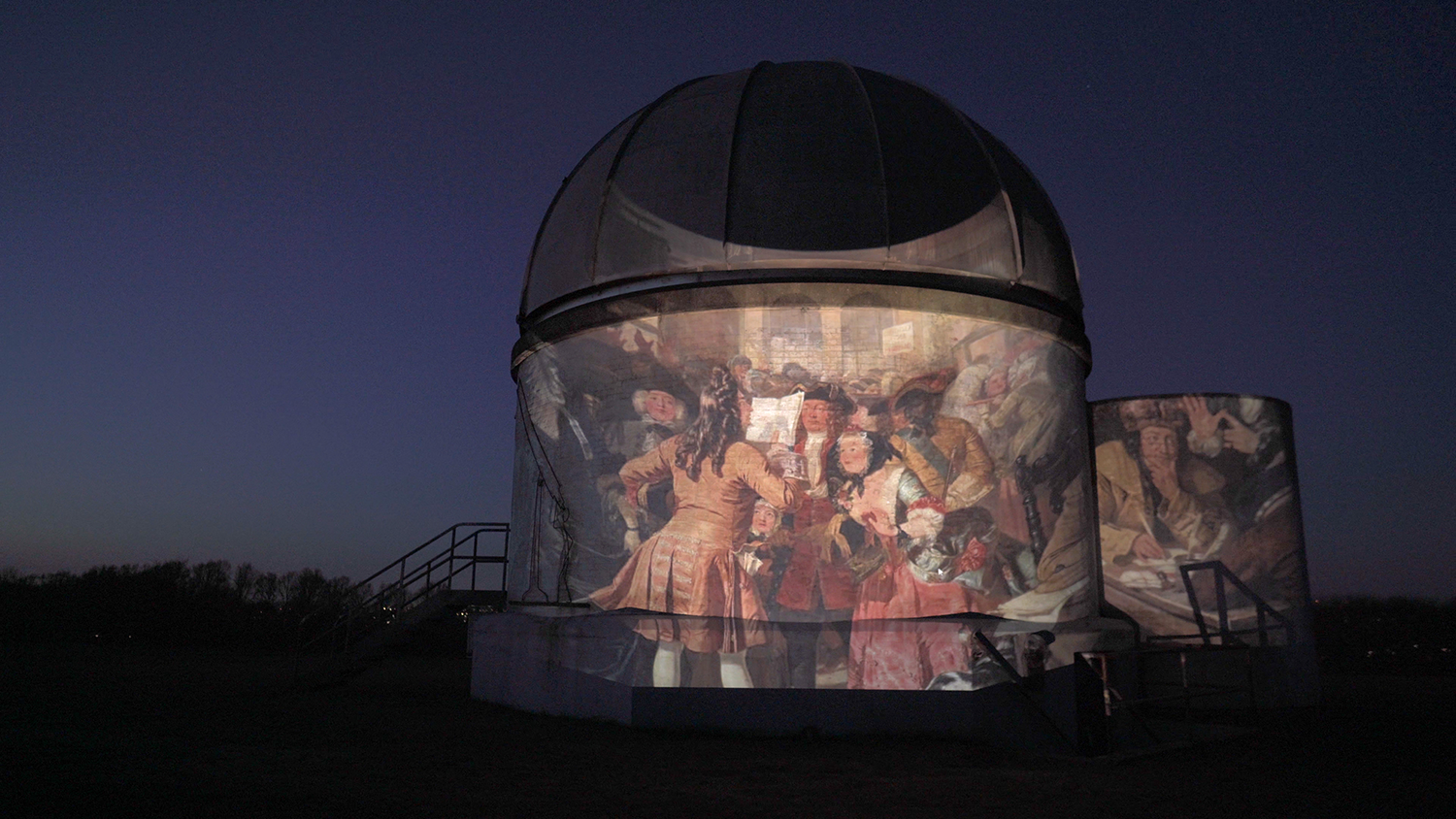VÆKST 2: Franziska Hoppe “Physics Envy”
VÆKST var en udstillingsserie fra september 2021 til marts 2022, der kritisk undersøgte vores samfunds fokus på vækst, effektivisering og udvikling. I Villa Kulturs orangeri — et væksthus for planter - forgrenede fem udstillinger sig, skabt af unge danske billedkunstnere fra det såkaldte vækstlag i Danmark. Under kronen af et kæmpe figentræ, indrammet af marmorfliser og store vinduespartier, rykkede kunstværker skabt af beton, marmor, plastik, LED, lyd, video og tekstiler ind, og skabte nye fortællinger på tværs af tid og sted. Fra renæssancen til samtiden, fra Zanzibar til Danmark, på hospitalet, til før-festen og på en rejse ud i rummet og dybt ned i historien. VÆKST blev støttet af Roskilde Festival Fonden, Slots- og Kulturstyrelsen, Østerbro Lokaludvalg, Statens Kunstfond, Snabslanten og Dansk Tennis Fond.
In English below
Physics Envy (2021)
I billedkunstner og forfatter Franziska Hoppes udstilling Physics Envy, undersøger videoværket af samme navn, hvordan økonomiens såkaldte naturlove ikke er helt så naturlige endda. Gennem videoens fire essayistiske nedslag, besøger Hoppe nogle af den økonomiske disciplins forfædre, der har sat tonen for vores vækstfokuserede samfund.
I novembermørket lyser Physics Envy (2021) væksthuset op i Villa Kultur og inviterer publikum til at fordybe sig i en anden økonomisk fortælling end den gængse. I væksthusets menneskeskabte, kunstige natur viser Hoppe, hvordan kapitalismen er blevet portrætteret som en del af naturen, mens hvide puffer forlænger videoens univers ud i rummet som små observatorier. I videoværket blander nattehimmelens stjerneformationer sig med historisk materiale projekteret på Observatoriet Uranias facade. Her begynder Hoppe sin spekulative og biografiske fortælling om forskellige økonomers fascination af Isaac Newton, og om hvad det har betydet for økonomien og menneskene i den.
Vi besøger Isaac Newton under en pest-lockdown i 1665, Adam Smiths barndomshjem i 1776 og marginalisterne i et observatorium i 1870’erne. Gennem fortællinger og visuelle projektioner lærer vi, at klasse, kolonial vold og kvinders traditionelle arbejde i hjemmet bekvemt blev ignoreret i deres økonomiske modeller. Mens Hoppe flytter rundt på farverige globusser uden for observatoriet reflekterer hun over, hvordan politik blev skubbet ud af den økonomiske disciplin, der ellers altid var blevet kaldt ‘political economy’. Med indtoget af matematiske ligninger og koordinatsystemer blev faget til blot ‘economics’, hvor mennesket måtte tilpasse de matematiske formler, opføre sig forudsigeligt og reduceres til et profitorienteret, egoistisk og isoleret individ – “the rational economic man”.
I videoens sidste del kan Hoppe dog konstatere, at der selv ikke videnskabens største stjerne var nogen ‘rational economic man’. I 1720 mistede Newton nemlig en kæmpe formue i den finanskrise, der gav de finansielle bobler deres navn “The South Sea Bubble”. I Hoppes fantasi falder han fortvivlet på knæ på Leicester Square, og med øjnene stift rettet mod stjernebilledet Orion udbryder han de berømte ord: “I can calculate the motion of heavenly bodies but not the madness of people”. Udstillingen er nummer to i udstillingsserien VÆKST, der inviterer unge vækstlagskunstnere til at reflektere over samfundets fokus på vækst. Med udstillingen Physics Envy bringer Hoppe videnskabens bias og økonomiens fiktion frem i lyset og bidrager til VÆKST med en nødvendig kritik af den teoretiske og historiske kontekst for vores samfunds fokus på økonomisk vækst. For “knowledge itself is power” citerer Hoppe den britiske filosof Francis Bacon for at have sagt, mens hun viser os, at andre narrativer kan konstrueres – også i kunstens grænsefelt mellem fiktion, fakta og fantasi.
Se videoen her.
Tekster skrevet af Ida Schyum & Nanna Saplana
Billeder taget af David Stjernholm
Om kunstneren
Franziska Hoppe (f.1990) blev MFA fra Det Kgl. Danske Kunstakademis Billedkunstskoler i 2021 og er uddannet forfatter fra Litterär Gestaltning i Göteborg. Senest har hun udgivet Quijote! Quijote! i et samarbejde mellem Forlaget Korridor og det tidligere Institut for Kunst, Skrift og Forskning på Det Kgl. Danske Kunstakademi.
Om kuratorerne
Ida Schyum (f.1992) er en dansk kunsthistoriker uddannet fra Københavns Universitet. Hun er kurator for Museet for Samtidskunst i Roskilde og har tidligere været kurator på O-Overgaden — Institut for Samtidskunst og Roskilde Festival, foruden at have kurateret freelance på Kunsthal Charlottenborg, ARoS, Alt_Cph20, Galleri Tom Christoffersen og Villa Kultur. Flere af hendes udstillinger er blevet hyldet som årets bedste i bl.a. Information, Kunsten.nu og Kunstkritikk samt præmieret af Statens Kunstfond.
Nanna Saplana (f. 1991) er en dansk cand.mag i Moderne Kultur uddannet fra Københavns Universitet og Visuel Antropologi fra Goldsmiths University i London. Hun er Gallery Director for Gas9Gallery på Vesterbro, København, og har tidligere arbejdet på Art Hub Copenhagen og O-Overgaden — Institut for Samtidskunst, foruden at have kurateret freelance på Nikolaj Kunsthal, @ Læderstræde og Villa Kultur.
Physics Envy (2021)
GROWTH 2: Franziska Hoppe “Physics Envy”
GROWTH was an exhibition series lasting from September 2021 to March 2022 that critically examined our society’s focus on growth, efficiency and development. In Villa Kultur’s greenhouse, five exhibitions branched out, each created by young Danish visual artists from the so-called ‘growth layer’ in Denmark. Under the crown of a giant fig tree and framed by marble tiles and large windows, works of art made from concrete, marble, plastic, sound, light, video and textiles moved in, creating new narratives across time and place. From the Renaissance to the present, from Zanzibar to Denmark, at the hospital, to the pre-party, and on a journey into space and deep into history. GROWTH was supported by Roskilde Festival Foundation, the Palaces and Culture Agency, Østerbro Local Committee, the Danish Arts Foundation, Snabslanten and the Danish Tennis Foundation.
In the exhibition Physics Envy by artist and author Franziska Hoppe, a video work of the same name examines how the so-called economic laws of nature are, in fact, not quite so natural. Through the video’s four essayistic sections, Hoppe visits some of the ancestors of the economic discipline who have set the tone for our growth-focused society.
In the November darkness, Physics Envy (2021) lights up the orangery in Villa Kultur and invites the audience to immerse themselves in an economic narrative different from the common one. In the orangery’s human-made, artificial nature, Hoppe shows how capitalism has been portrayed as part of nature, while white hassocks extend the video’s universe into the exhibition space as small observatories.
In the video work, star formations of the night sky mix with historical material projected on the facade of the Observatory Urania. Here, Hoppe begins her speculative and biographical narrative about different economists’ fascination with Isaac Newton and what it has meant for the economy and the people.
We visit Isaac Newton during a plague lockdown in 1665, Adam Smith’s childhood home in 1776 and followers of economic marginalism in an observatory in the 1870s. Through multiple narratives and visual projections, we learn that class, colonial violence, and women’s domestic labour were conveniently ignored in their economic models. While moving around colourful globes outside the observatory, Hoppe reflects on how politics was pushed out of the economic discipline – once exclusively known as ‘political economy’. With the advent of mathematical equations and coordinate systems, the discipline became ‘economics’; the human had to adapt to mathematical formulas, become predictable and thereby by reduced to a profit-oriented, selfish and isolated individual – ‘the rational economic man’.
However, in the last part of the video, Hoppe declares that not even the biggest star in science was a ‘rational economic man’. In 1720, Newton lost a large fortune in the crisis that gave financial bubbles their name, the South Sea Bubble. In Hoppe’s imagining, he falls desperately to his knees in Leicester Square and, with his eyes fixed on the star constellation Orion, exclaims the famous words: ‘I can calculate the motion of heavenly bodies but not the madness of people’.
With the solo show Physics Envy, Hoppe brings the bias of science and the fiction of economics to light and contributes to GROWTH with a necessary critique of the theoretical and historical context of our society’s focus on economic growth. ‘Knowledge itself is power’, Hoppe quotes British philosopher Francis Bacon, while showing us that other narratives can be constructed – including in the artistic field at the boundaries between fiction, fact and fantasy.
Watch the video here.
Texts by Ida Schyum & Nanna Saplana
Photos by David Stjernholm
About the artist
Franziska Hoppe (b. 1990) graduated in 2021 from the MFA programme at the Royal Danish Academy of Fine Arts in Copenhagen and studied at Litterär Gestaltning in Gothenburg. Most recently, she has released the publication Quijote! Quijote! in a collaboration between Forlaget Korridor and the former Department of Art, Writing and Research at the Royal Danish Academy of Fine Arts.
About the curators
Ida Schyum (b. 1992) is a Danish art historian educated at the University of Copenhagen and a curator at the Museum of Contemporary Art in Roskilde. She was previously a curator at O-Overgaden — Institute of Contemporary Art and Roskilde Festival, as well as a freelance curator at Kunsthal Charlottenborg, ARoS, Alt_Cph20, Galleri Tom Christoffersen, and Villa Kultur. Her exhibitions have been selected as the best of the year in Information, Kunsten.nu, and Kunstkritikk as well as awarded by the Danish Arts Council.
Nanna Saplana (b. 1991) has a master’s degree in Modern Culture from the University of Copenhagen and is a graduate of Visual Anthropology at Goldsmiths, University of London. She is Gallery Director for Gas9Gallery on Vesterbro, Copenhagen, and has previously worked at Art Hub Copenhagen and O-Overgaden — Institute of Contemporary Art, in addition to curating freelance at Nikolaj Kunsthal, @Læderstræde, and Villa Kultur.








